Heuristic Methodology for Planning AC Rural Medium-Voltage Distribution Grids
Abstract
1. Introduction
2. Mathematical Modeling
2.1. Objective Function
2.2. Set of Constraints
3. Heuristic Solution Methodology
3.1. Selection of the Grid Topology
3.2. Selection of the Initial Conductors’ Size
- All the loads are connected in three-phase form with balanced consumption.
- The ideal currents consumed by the loads are calculated by using the nominal grid voltage .
- The current at each line is calculated by adding the currents consumed at the nodes downstream this line.
- The selection of the conductor size for each line corresponds to the conductor with a thermal condition that does not exceed the of chargeability.
3.3. Optimization of the Grid Calibers
3.3.1. Initial Solution
3.3.2. Generation of the Neighborhood
- ✓
- A list with all the possible paths between the end nodes and the substation is created. Each of these paths is selected in a random manner, with one branch modifying its caliber; next, all the calibers in this path are revised and changed to ensure the telescopic condition of the feeder.
- ✓
- A list with the nodes that present the worse voltage regulation is formed. For each of the paths between these nodes and the substation, the caliber of the conductors is increased to the next value with superior current capability.
- ✓
- The branch with the lowest loadability factor is selected and its caliber is reduced; then, all the branches downstream are revised and modified to ensure the telescopic configuration of the feeder.
- ✓
- An arbitrary path from the substation of one end node is selected and all the calibers of this path are assigned to the same caliber; then, the branches that are connected with this path are revised to ensure the telescopic configuration of the grid.
3.3.3. Evaluation of the Neighborhood
3.3.4. Selection of the Next Solution
- In order to select , the best neighbor in the current neighborhood is considered if it has the a better fitness function than the current solution . This corresponds to the application of the criterion in the TSA, known as the aspiration criterion.
- If the aspiration criteria are not fulfilled, the selection of is associated with the individual in the neighborhood with less locked tabu attributes; this allows degradation in the objective function value that, in turn, allows the TSA to escape from the local optimal solutions in order to explore other promising solution regions.
3.3.5. Computational Implementation of the TSA
| Algorithm 1: General implementation of the TSA to determine the optimal subset of calibers for all the routes in a three-phase symmetric distribution grid. |
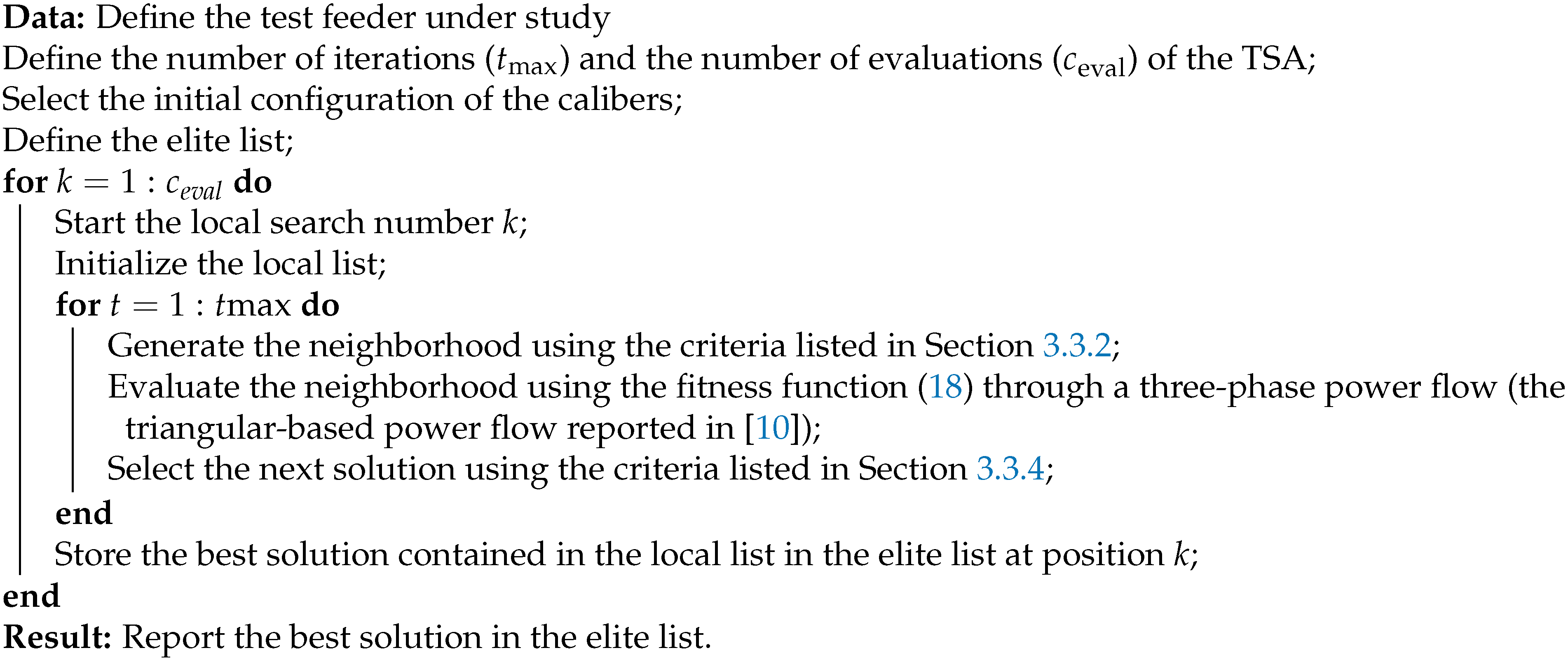 |
4. Test Feeders
4.1. Nine-Bus Test Feeder
4.2. Twenty-Five-Bus Test Feeder
5. Computational Implementation
5.1. Nine-Bus System
5.2. Twenty-Five-Bus System
- ✓
- All the solutions (without the starting points) produce annual costs between USD 270,157.5108 and USD 279,685.1245, which implies a difference of USD , i.e., , using solution two presented in Table 12 as the base.
- ✓
- The initial configurations obtained by using the ideal current consumption provide at least of the optimal solution for both configurations. This demonstrates the effectiveness of the constructive algorithm to provide an adequate starting point to the TSA that allows improving it with small processing times, less than 70 s, in all the consecutive evaluations.
- ✓
- The behavior of the voltage profiles in both configurations confirms that the worst voltage regulation always occur in one of the ending nodes, while a maximum of 7% is achieved in all the results obtained for both configurations.
6. Conclusions and Future Work
Author Contributions
Funding
Institutional Review Board Statement
Informed Consent Statement
Data Availability Statement
Acknowledgments
Conflicts of Interest
Nomenclature
| Positive constant associated with the violation of the current flow in the lines of the network USD/A | |
| Positive constant associated with the violation of the voltages in the nodes of the network USD/V | |
| Length of the route that connects nodes i and j (km) | |
| Binary variable that determines if the caliber type c is selected for route | |
| Binary parameter that determines if there is or there is not a conductor type c in route | |
| Cost of changing a conductor type e in route (USD) | |
| Cost of installing a new conductor type e in route (USD) | |
| Interest rate to transform future values into net present values (%) | |
| Interest rate associated with the increments in energy costs (%) | |
| Cost of the energy losses (USD/kWh) | |
| Duration of the period of time h (h) | |
| Resistance of the conductor type c connected in route () | |
| RMS value of the current that flows in the route at phase f in the period of time h (A) | |
| Cost of leaving an existing conductor out of service (USD) | |
| Set that contains the lengths of the periods of time in which a year was divided | |
| Set that contains all the years of the planning horizon | |
| Set that contains all the phases of the grid | |
| Represents the cost of changing an existing conductor in route (USD) | |
| Represents the cost of constructing a line in route (USD) | |
| Represents the annual cost because of the energy dissipated by the resistive effect of conductors in route (USD) | |
| Corresponds to the cost of disconnecting an existing conductor in route to leave it out of service (USD) | |
| Denotes a set that contains all the possible routes in the distribution system graph | |
| Denotes a set that contains all the conductors’ calibers available for installation | |
| y | Number of years considered in the planning horizon |
| Nonlinear functions associated with the active and reactive power balances at each node | |
| Active power demand values associated with node k at phase f in the period of time h (W) | |
| Reactive power demand values associated with node k at phase f in the period of time h (var) | |
| RMS value of the voltage at phase f at node k in the period of time h (V) | |
| Angle of the voltage at phase f at node k in the period of time h (rad) | |
| Minimum voltage regulation bound allowed for all nodes of the grid (V) | |
| Maximum voltage regulation bound allowed for all nodes of the grid (V) | |
| Maximum current bound allowed for a conductor with caliber type c (A) | |
| n | Number of nodes of the network |
| s | Number of substations of the network |
References
- Picard, J.L.; Aguado, I.; Cobos, N.G.; Fuster-Roig, V.; Quijano-López, A. Electric Distribution System Planning Methodology Considering Distributed Energy Resources: A Contribution towards Real Smart Grid Deployment. Energies 2021, 14, 1924. [Google Scholar] [CrossRef]
- Riaño, F.E.; Cruz, J.F.; Montoya, O.D.; Chamorro, H.R.; Alvarado-Barrios, L. Reduction of Losses and Operating Costs in Distribution Networks Using a Genetic Algorithm and Mathematical Optimization. Electronics 2021, 10, 419. [Google Scholar] [CrossRef]
- Li, R.; Wang, W.; Chen, Z.; Jiang, J.; Zhang, W. A Review of Optimal Planning Active Distribution System: Models, Methods, and Future Researches. Energies 2017, 10, 1715. [Google Scholar] [CrossRef]
- Lavorato, M.; Franco, J.F.; Rider, M.J.; Romero, R. Imposing Radiality Constraints in Distribution System Optimization Problems. IEEE Trans. Power Syst. 2012, 27, 172–180. [Google Scholar] [CrossRef]
- Farrag, M. A new model for distribution system planning. Int. J. Electr. Power Energy Syst. 1999, 21, 523–531. [Google Scholar] [CrossRef]
- Mejía-Solanilla, A.M.; Hincapié-Isaza, R.A.; Gallego-Rendón, R.A. Optimal planning of distribution systems considering multiple objectives: Investment cost, reliability and technical losses. Rev. Tecnura 2015, 19, 106. [Google Scholar] [CrossRef]
- Dong, Y.F.; Gu, J.H.; Li, N.N.; Hou, X.D.; Yan, W.L. Combination of Genetic Algorithm and Ant Colony Algorithm for Distribution Network Planning. In Proceedings of the 2007 IEEE International Conference on Machine Learning and Cybernetics, Hong Kong, China, 19–22 August 2007. [Google Scholar] [CrossRef]
- Kilyeni, S.; Barbulescu, C.; Simo, A.; Teslovan, R.; Oros, C. Genetic algorithm based distribution network expansion planning. In Proceedings of the 2014 IEEE 49th International Universities Power Engineering Conference (UPEC), Cluj-Napoca, Romania, 2–5 September 2014. [Google Scholar] [CrossRef]
- Montoya, O.D.; Grajales, A.; Hincapié, R.A.; Granada, M. A new approach to solve the distribution system planning problem considering automatic reclosers. Ing. Rev. Chil. Ing. 2017, 25, 415–429. [Google Scholar] [CrossRef][Green Version]
- Montoya, O.D.; Giraldo, J.S.; Grisales-Noreña, L.F.; Chamorro, H.R.; Alvarado-Barrios, L. Accurate and Efficient Derivative-Free Three-Phase Power Flow Method for Unbalanced Distribution Networks. Computation 2021, 9, 61. [Google Scholar] [CrossRef]
- Mohamad, H.; Zalnidzham, W.I.F.W.; Salim, N.A.; Shahbudin, S.; Yasin, Z.M. Power system restoration in distribution network using minimum spanning tree—Kruskal’s algorithm. Indones. J. Electr. Eng. Comput. Sci. 2019, 16, 1–8. [Google Scholar] [CrossRef]
- Lavorato, M.; Rider, M.J.; Garcia, A.V.; Romero, R. Distribution network planning using a constructive heuristic algorithm. In Proceedings of the 2009 IEEE Power & Energy Society General Meeting, Calgary, AB, Canada, 26–30 July 2009. [Google Scholar] [CrossRef]
- Montoya, O.; Grajales, A.; Hincapié, R. Optimal selection of conductors in distribution systems using tabu search algorithm. Ing. Rev. Chil. Ing. 2018, 26, 283–295. [Google Scholar] [CrossRef]
- Granada, M.; Gallego-Rendón, R.A.; López-Lezama, J.M. Optimal Phase Balancing Planning for Loss Reduction in Distribution Systems using a Specialized Genetic Algorithm. Ing. Cienc. 2012, 8, 121–140. [Google Scholar] [CrossRef]
- Rao, B.; Kupzog, F.; Kozek, M. Three-Phase Unbalanced Optimal Power Flow Using Holomorphic Embedding Load Flow Method. Sustainability 2019, 11, 1774. [Google Scholar] [CrossRef]
- Cortés-Caicedo, B.; Avellaneda-Gómez, L.S.; Montoya, O.D.; Alvarado-Barrios, L.; Chamorro, H.R. Application of the Vortex Search Algorithm to the Phase-Balancing Problem in Distribution Systems. Energies 2021, 14, 1282. [Google Scholar] [CrossRef]
- Lavorato, M.; Rider, M.J.; Garcia, A.V.; Romero, R. A Constructive Heuristic Algorithm for Distribution System Planning. IEEE Trans. Power Syst. 2010, 25, 1734–1742. [Google Scholar] [CrossRef]
- Fan, N.; Golari, M. Integer Programming Formulations for Minimum Spanning Forests and Connected Components in Sparse Graphs. In Combinatorial Optimization and Applications; Springer International Publishing: New York, NY, USA, 2014; pp. 613–622. [Google Scholar] [CrossRef]
- Haouari, M.; Chaouachi, J.; Dror, M. Solving the generalized minimum spanning tree problem by a branch-and-bound algorithm. J. Oper. Res. Soc. 2005, 56, 382–389. [Google Scholar] [CrossRef]
- Malamaki, K.N.D.; Konstantinidis, I.; Demoulias, C.S. Analytical evaluation of the annual load duration curve of domestic prosumers. In Proceedings of the 2017 IEEE Manchester PowerTech, Manchester, UK, 18–22 June 2017. [Google Scholar] [CrossRef]
- Caserta, M. Tabu Search-Based Metaheuristic Algorithm for Large-scale Set Covering Problems. In Metaheuristics; Springer: New York, NY, USA, 2007; pp. 43–63. [Google Scholar] [CrossRef]
- Xing, L.; Liu, Y.; Li, H.; Wu, C.C.; Lin, W.C.; Chen, X. A Novel Tabu Search Algorithm for Multi-AGV Routing Problem. Mathematics 2020, 8, 279. [Google Scholar] [CrossRef]
- Tang, F.; Zhou, H.; Wu, Q.; Qin, H.; Jia, J.; Guo, K. A Tabu Search Algorithm for the Power System Islanding Problem. Energies 2015, 8, 11315–11341. [Google Scholar] [CrossRef]
- Lucay, F.; Gálvez, E.; Cisternas, L. Design of Flotation Circuits Using Tabu-Search Algorithms: Multispecies, Equipment Design, and Profitability Parameters. Minerals 2019, 9, 181. [Google Scholar] [CrossRef]
- Ismael, S.M.; Aleem, S.H.E.A.; Abdelaziz, A.Y. Optimal selection of conductors in Egyptian radial distribution systems using sine-cosine optimization algorithm. In Proceedings of the IEEE 2017 Nineteenth International Middle East Power Systems Conference (MEPCON), Cairo, Egypt, 19–21 December 2017. [Google Scholar] [CrossRef]
- Martínez-Gil, J.F.; Moyano-García, N.A.; Montoya, O.D.; Alarcon-Villamil, J.A. Optimal Selection of Conductors in Three-Phase Distribution Networks Using a Discrete Version of the Vortex Search Algorithm. Computation 2021, 9, 80. [Google Scholar] [CrossRef]
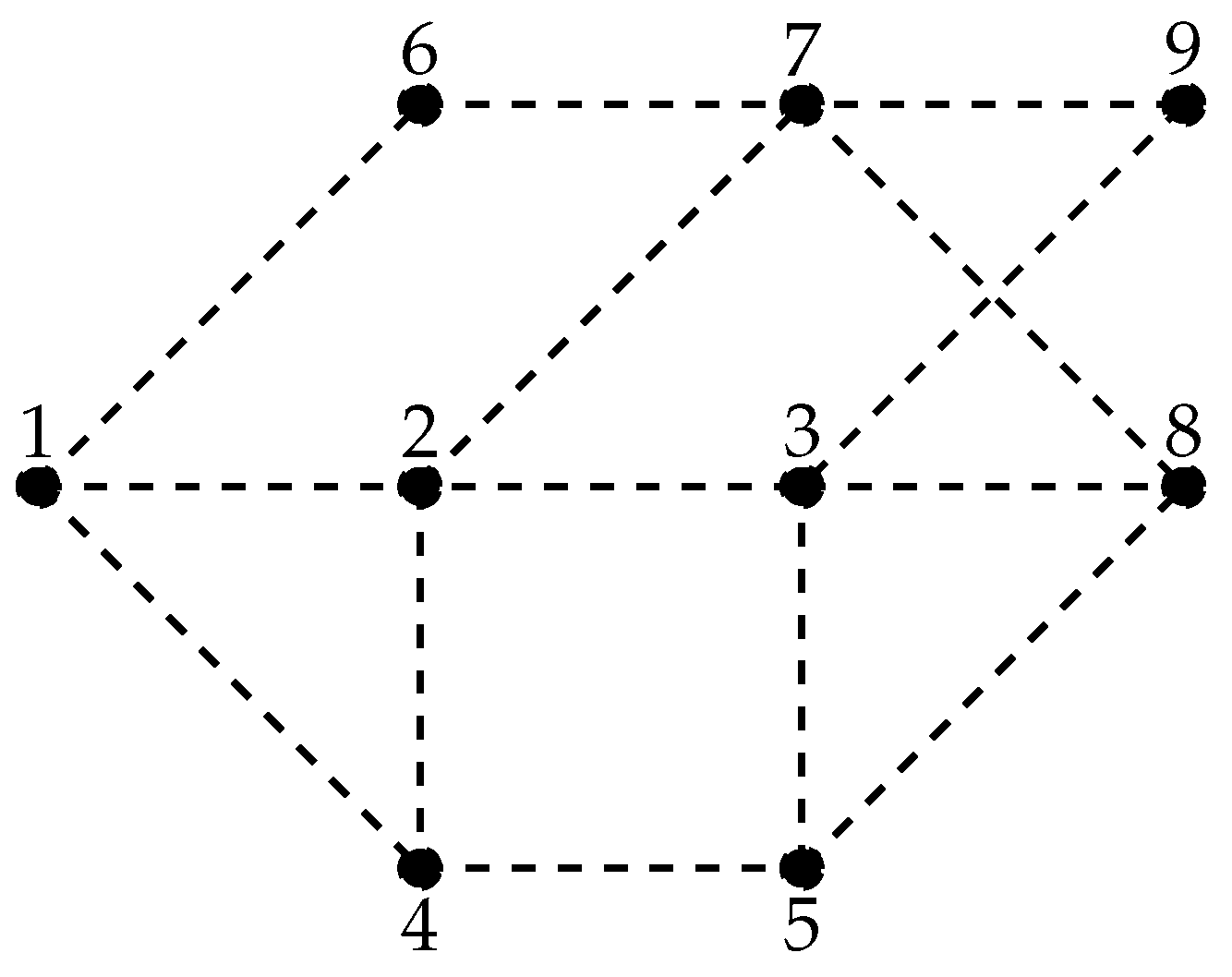
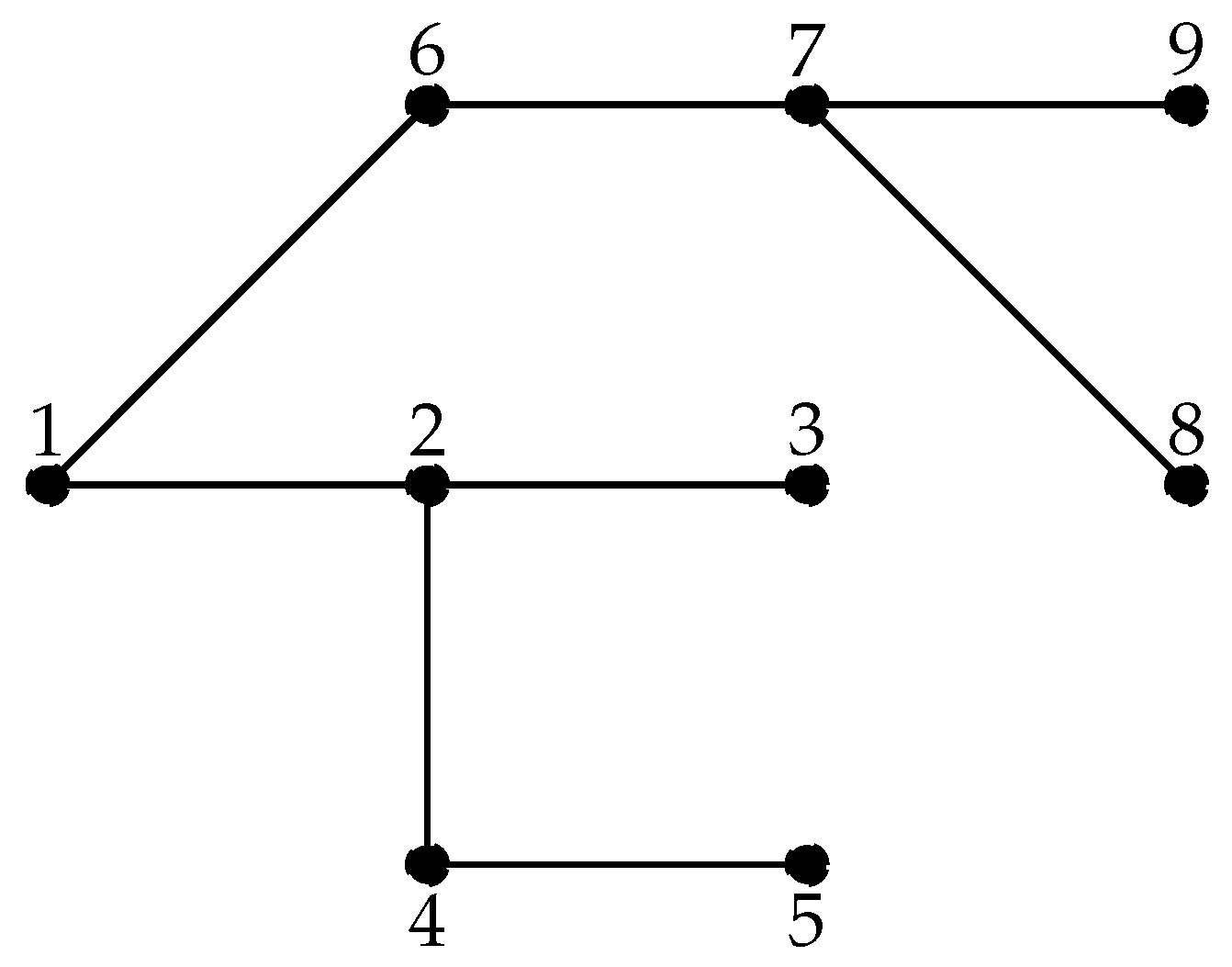
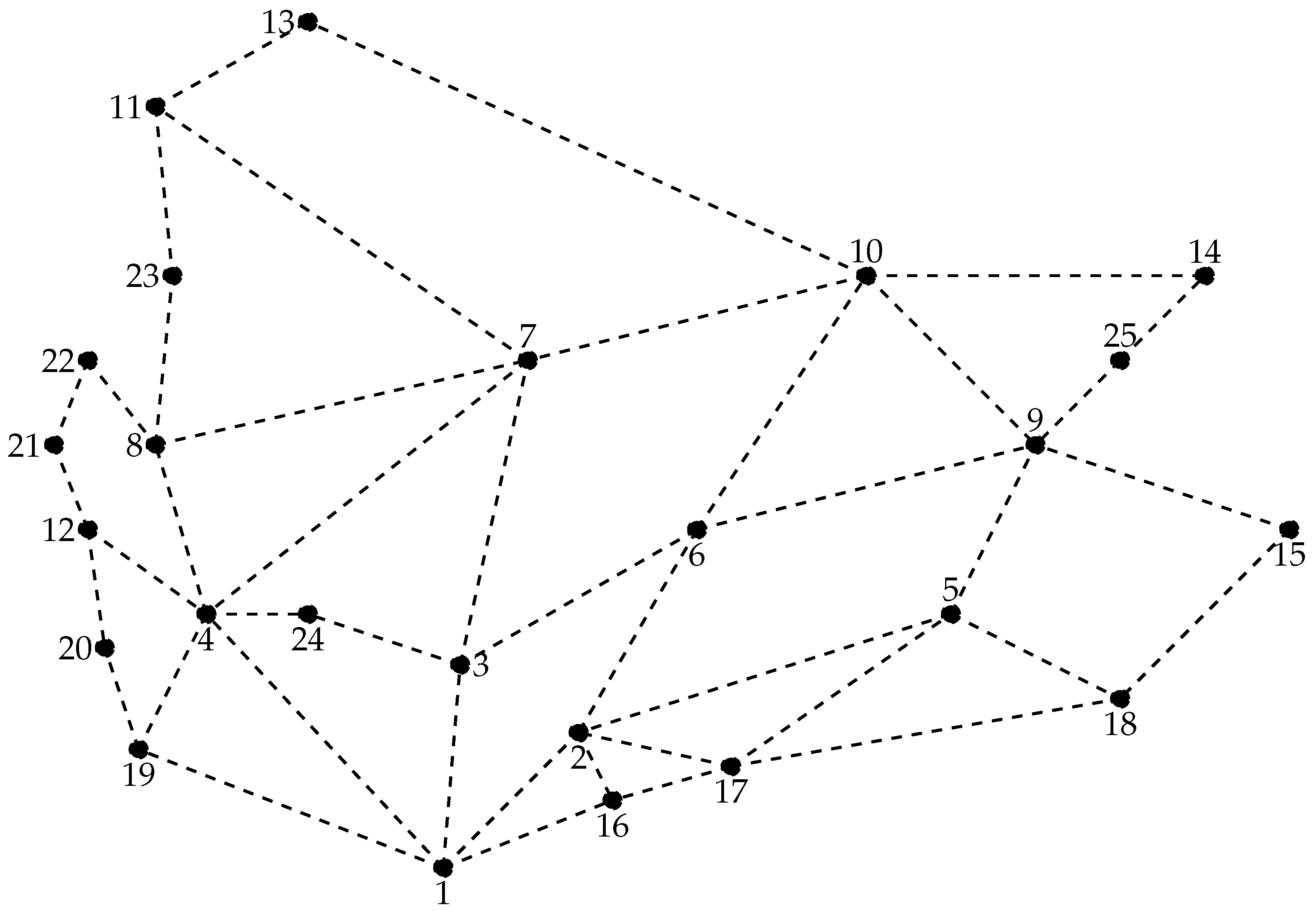
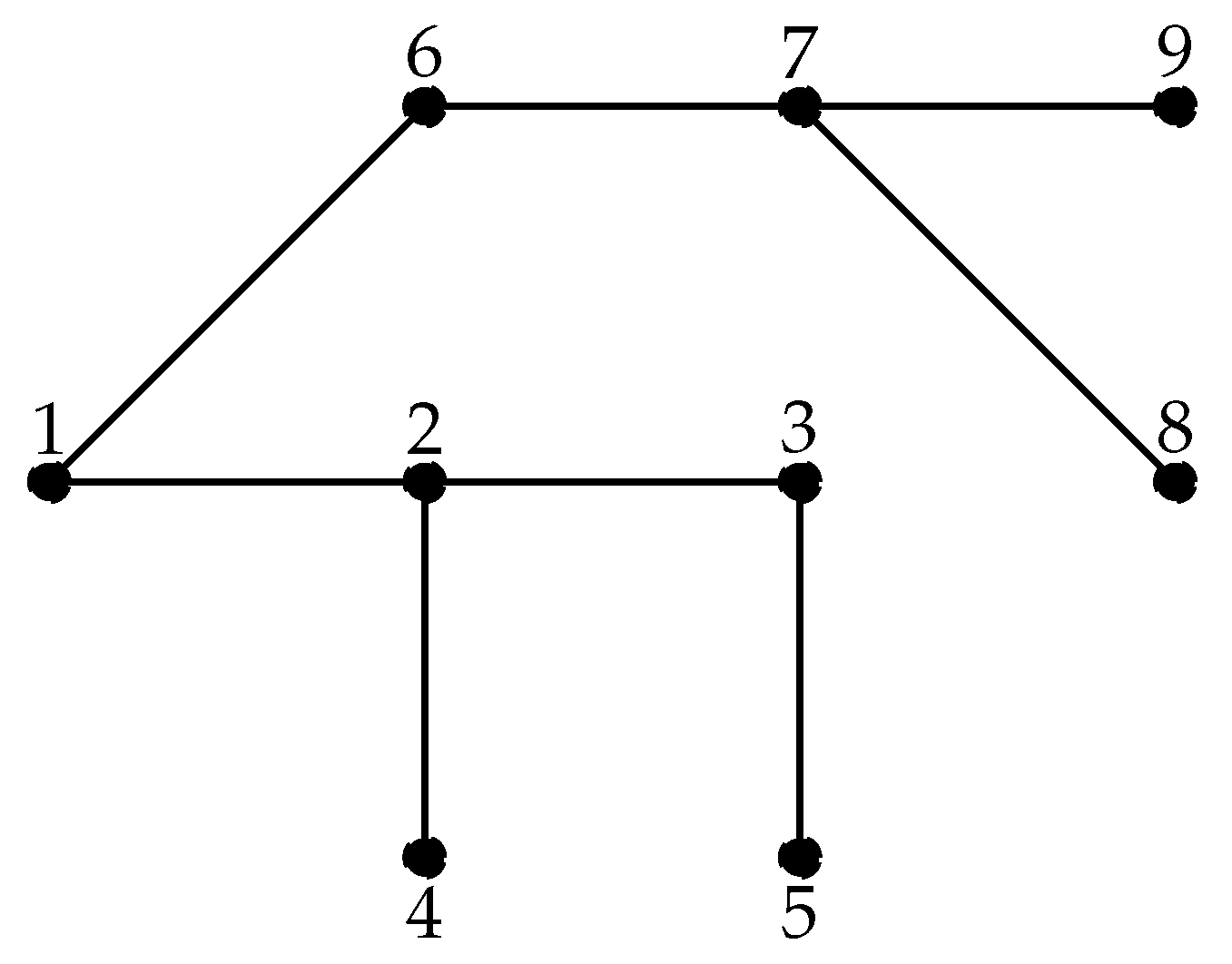
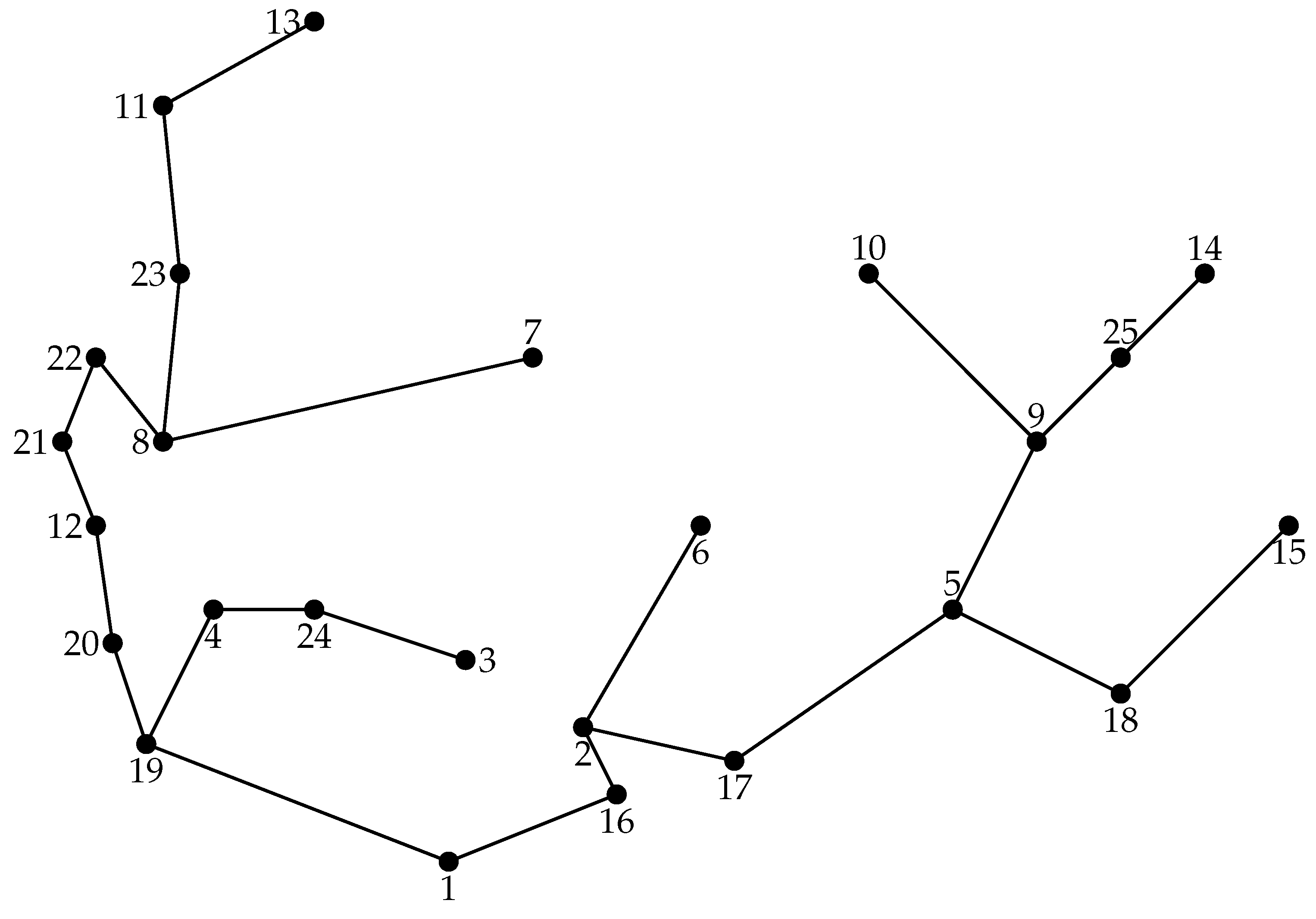
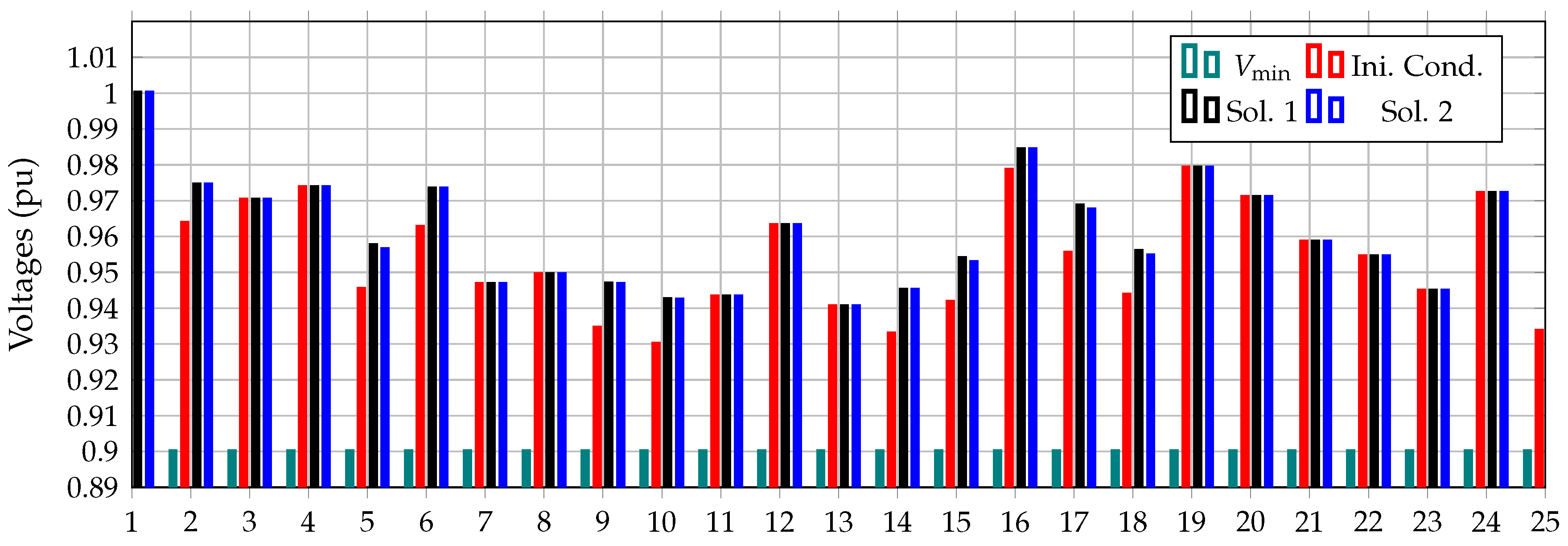
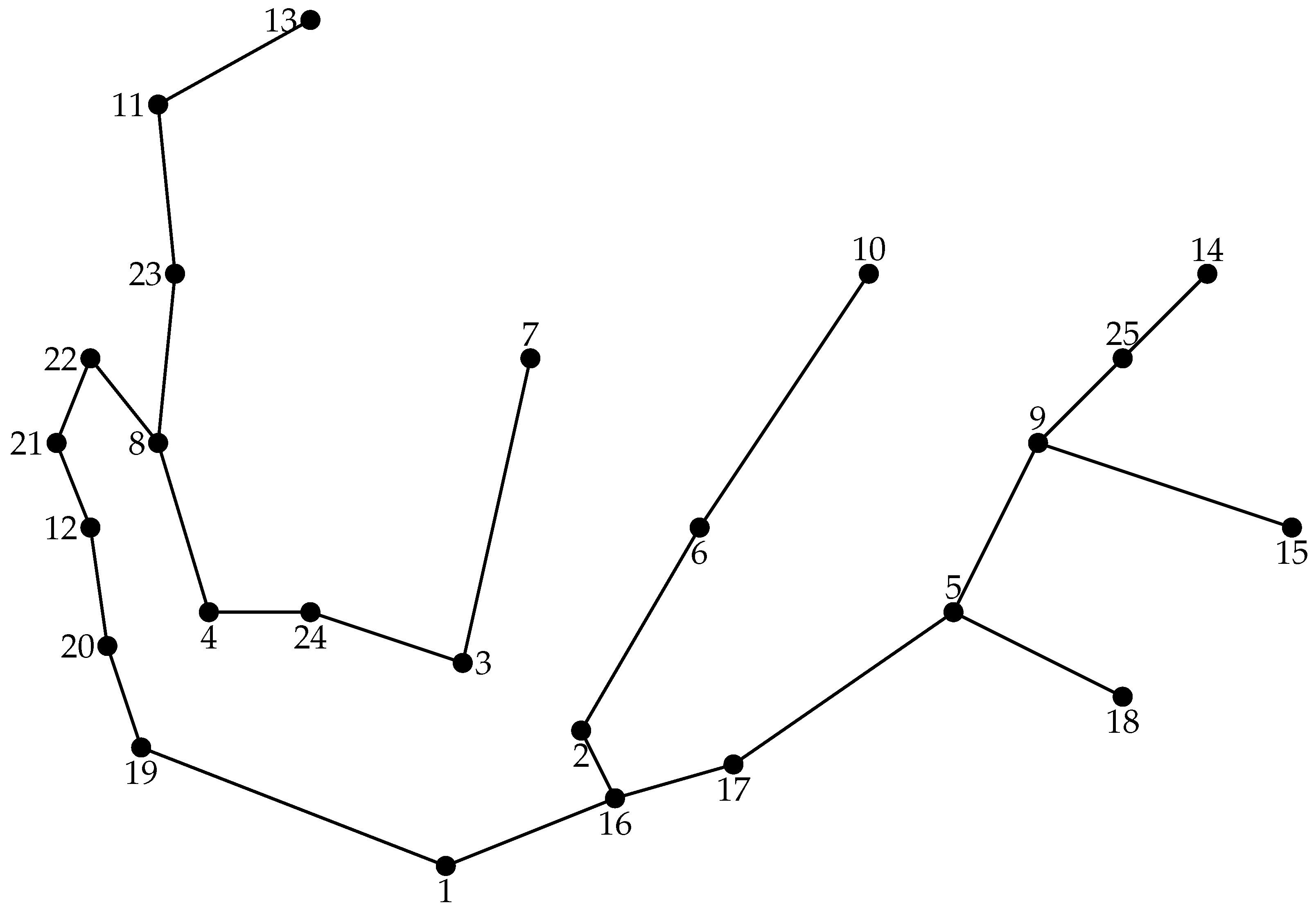
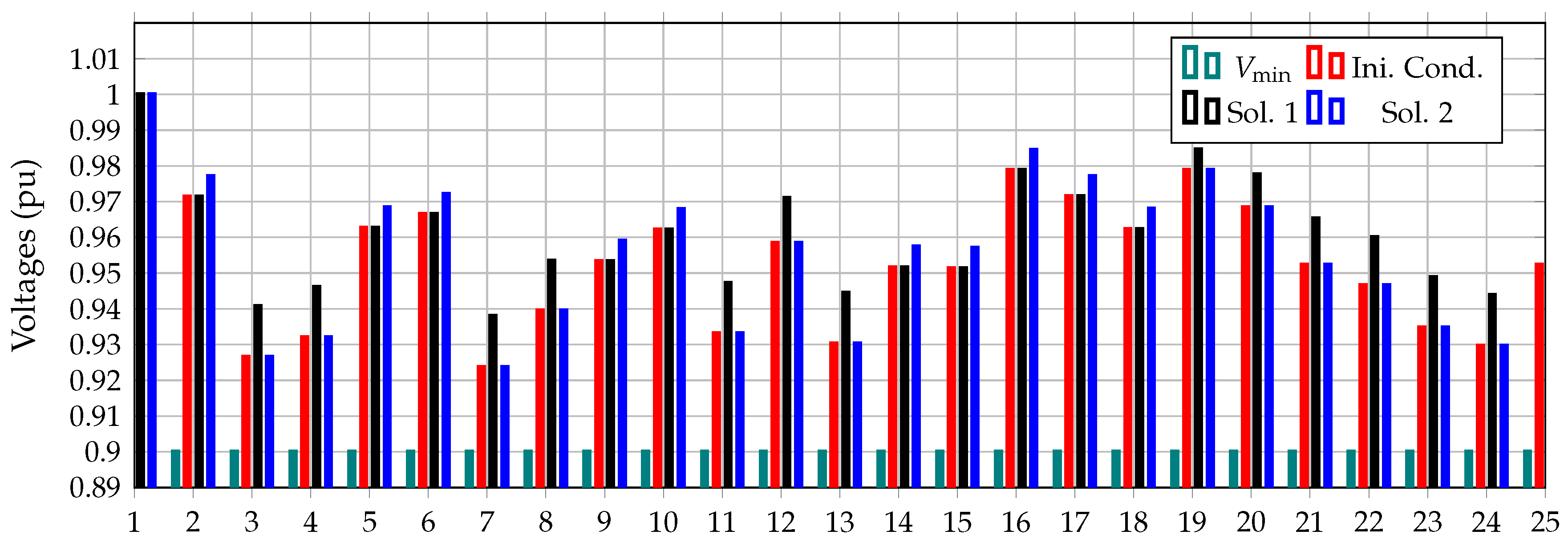
| Route | Length (m) | Route | Length (m) |
|---|---|---|---|
| 1-2 | 400 | 3-8 | 920 |
| 1-4 | 850 | 3-9 | 875 |
| 1-6 | 600 | 4-5 | 650 |
| 2-3 | 650 | 5-8 | 1000 |
| 2-4 | 650 | 6-7 | 650 |
| 2-7 | 825 | 7-8 | 800 |
| 3-5 | 650 | 7-9 | 720 |
| Caliber | Current (A) | Costs (USD/km) | Resistance (/km) | Reactance (/km) |
|---|---|---|---|---|
| 1 | 75 | 1500 | 0.80 | 0.50 |
| 2 | 100 | 2000 | 0.72 | 0.45 |
| 3 | 125 | 2750 | 0.65 | 0.40 |
| 4 | 150 | 3000 | 0.60 | 0.40 |
| 5 | 175 | 3500 | 0.55 | 0.36 |
| 6 | 200 | 4200 | 0.45 | 0.32 |
| 7 | 225 | 4700 | 0.40 | 0.28 |
| Node | Load (kW) | Node | Load (kW) |
|---|---|---|---|
| 2 | 850 | 6 | 1500 |
| 3 | 750 | 7 | 500 |
| 4 | 925 | 8 | 850 |
| 5 | 1000 | 9 | 1250 |
| (Line) Route | Current (A) | Caliber Selected | (Line) Route | Current (A) | Caliber Selected |
|---|---|---|---|---|---|
| (1) 1-2 | 171.3097 | 6 | (5) 1-6 | 199.2538 | 7 |
| (2) 2-3 | 36.4489 | 1 | (6) 6-7 | 126.3561 | 4 |
| (3) 2-4 | 93.5521 | 3 | (7) 7-8 | 41.3087 | 1 |
| (4) 4-5 | 48.5985 | 1 | (8) 7-9 | 60.7481 | 1 |
| Node Load (kVA) | Node Load (kVA) | Node Load (kVA) | Node Load (kVA) | Node Load (kVA) | Node Load (kVA) |
|---|---|---|---|---|---|
| 2 (625) | 3 (400) | 4 (250) | 5 (250) | 6 (125) | 7 (250) |
| 8 (250) | 9 (625) | 10 (400) | 11 (250) | 12 (400) | 13 (250) |
| 14 (250) | 15 (250) | 16 (375) | 17 (200) | 18 (100) | 19 (250) |
| 20 (100) | 21 (150) | 22 (100) | 23 (200) | 24 (250) | 25 (75) |
| Branch Length (km) | Branch Length (km) | Branch Length (km) | Branch Length (km) | Branch Length (km) | Branch Length (km) |
|---|---|---|---|---|---|
| 1 (2.10) | 2 (1.65) | 3 (2.20) | 4 (2.00) | 5 (1.50) | 6 (1.75) |
| 7 (1.75) | 8 (1.75) | 9 (1.00) | 10 (1.00) | 11 (1.25) | 12 (1.50) |
| 13 (1.75) | 14 (2.00) | 15 (2.00) | 16 (1.75) | 17 (1.25) | 18 (1.75) |
| 19 (1.75) | 20 (2.75) | 21 (1.75) | 22 (1.50) | 23 (1.05) | 24 (0.75) |
| 25 (1.05) | 26 (1.00) | 27 (1.50) | 28 (0.75) | 29 (1.25) | 30 (1.55) |
| 31 (1.00) | 32 (0.75) | 33 (0.75) | 34 (0.50) | 35 (0.50) | 36 (1.05) |
| 37 (0.50) | 38 (0.65) | 39 (0.75) | 40 (0.45) | 41 (0.50) | 42 (0.40) |
| Branch Nodes | Branch Nodes | Branch Nodes | Branch Nodes | Branch Nodes | Branch Nodes |
|---|---|---|---|---|---|
| 1 (1-2) | 2 (1-3) | 3 (1-4) | 4 (2-5) | 5 (2-6) | 6 (3-6) |
| 7 (3-7) | 8 (4-7) | 9 (4-8) | 10 (4-12) | 11 (5-9) | 12 (6-9) |
| 13 (6-10) | 14 (7-10) | 15 (7-11) | 16 (7-8) | 17 (9-15) | 18 (9-10) |
| 19 (10-14) | 20 (10-13) | 21 (11-13) | 22 (1-16) | 23 (2-16) | 24 (16-17) |
| 25 (2-17) | 26 (5-17) | 27 (17-18) | 28 (5-18) | 29 (15-18) | 30 (1-19) |
| 31 (4-19) | 32 (19-20) | 33 (12-20) | 34 (12-21) | 35 (21-22) | 36 (8-23) |
| 37 (11-23) | 38 (8-22) | 39 (3-24) | 40 (9-25) | 41 (14-25) | 42 (4-24) |
| Method | Type of Calibers | Cost of Calibers (USD) | Cost of Losses (USD) | (USD) | Time (s) |
|---|---|---|---|---|---|
| Without initial condition | |||||
| TSA | 45,173.2614 | 37,890 | 83,063.2614 | 12.20 | |
| SCA | 44,231.9946 | 40,695 | 84,926.9946 | 28.73 | |
| With initial condition | |||||
| Ini. Cond. | 44,857.3340 | 37,402.50 | 82,259.8340 | — | |
| TSA | 44,577.2797 | 36,540 | 81,117.2797 | 14.35 | |
| SCA | 44,857.3340 | 37,402.50 | 82,259.8340 | 28.76 | |
| (Line) Route | Current (A) | Caliber Selected | (Line) Route | Current (A) | Caliber Selected |
|---|---|---|---|---|---|
| (1) 1-2 | 171.3097 | 6 | (5) 1-6 | 199.2538 | 7 |
| (2) 2-3 | 85.0474 | 2 | (6) 6-7 | 126.3561 | 4 |
| (3) 2-4 | 44.9536 | 1 | (7) 7-8 | 41.3087 | 1 |
| (4) 3-5 | 48.5985 | 1 | (8) 7-9 | 60.7481 | 1 |
| Method | Type of Calibers | Cost of Calibers (USD) | Cost of Losses (USD) | (USD) | Time (s) |
|---|---|---|---|---|---|
| Without initial condition | |||||
| TSA | 42,735.0346 | 39,795 | 82,530.0346 | 12.13 | |
| With initial condition | |||||
| Ini. Cond. | 44,928.4881 | 35,940 | 80,868.4881 | — | |
| TSA | 44,041.0708 | 36,540 | 80,581.0708 | 14.41 | |
| Method | Type of Calibers | Cost of Calibers (USD) | Cost of Losses (USD) | (USD) |
|---|---|---|---|---|
| Ini. Cond. | 138,445.8843 | 138,262.50 | 276,708.3843 | |
| Sol. 1 (min) | 120,127.5108 | 150,030 | 270,157.5108 | |
| Sol. 2 (max) | 120,767.4154 | 150,330 | 271,097.4154 |
| Method | Type of Calibers | Cost of Calibers (USD) | Cost of Losses (USD) | (USD) |
|---|---|---|---|---|
| Ini. Cond. | 143,217.1922 | 140,287.50 | 283,504.6922 | |
| Sol. 1 (min) | 122,990.0448 | 154,755 | 277,745.0448 | |
| Sol. 2 (max) | 133,997.6245 | 145,687.50 | 279,685.1245 |
Publisher’s Note: MDPI stays neutral with regard to jurisdictional claims in published maps and institutional affiliations. |
© 2021 by the authors. Licensee MDPI, Basel, Switzerland. This article is an open access article distributed under the terms and conditions of the Creative Commons Attribution (CC BY) license (https://creativecommons.org/licenses/by/4.0/).
Share and Cite
Montoya, O.D.; Serra, F.M.; De Angelo, C.H.; Chamorro, H.R.; Alvarado-Barrios, L. Heuristic Methodology for Planning AC Rural Medium-Voltage Distribution Grids. Energies 2021, 14, 5141. https://doi.org/10.3390/en14165141
Montoya OD, Serra FM, De Angelo CH, Chamorro HR, Alvarado-Barrios L. Heuristic Methodology for Planning AC Rural Medium-Voltage Distribution Grids. Energies. 2021; 14(16):5141. https://doi.org/10.3390/en14165141
Chicago/Turabian StyleMontoya, Oscar Danilo, Federico Martin Serra, Cristian Hernan De Angelo, Harold R. Chamorro, and Lazaro Alvarado-Barrios. 2021. "Heuristic Methodology for Planning AC Rural Medium-Voltage Distribution Grids" Energies 14, no. 16: 5141. https://doi.org/10.3390/en14165141
APA StyleMontoya, O. D., Serra, F. M., De Angelo, C. H., Chamorro, H. R., & Alvarado-Barrios, L. (2021). Heuristic Methodology for Planning AC Rural Medium-Voltage Distribution Grids. Energies, 14(16), 5141. https://doi.org/10.3390/en14165141










